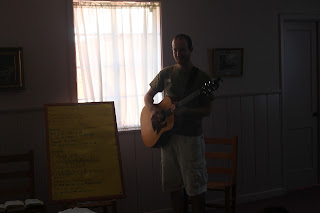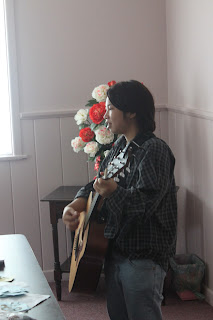“Rothenburg ob der Tauber 4 km,” a sign announces as the car drifts to as stop at a “T” in the road. Samuel puts the car into gear and I rouse myself from a nap as we lurch forward and turn left. I crank up the seat to an upright position to catch a glimpse of the rolling hills of corn and wheat.
One century ago, a great
grandfather of mine emigrated from this town according to my cousin’s research.
My late grandmother’s stories placed her father’s hometown as Nuremberg, which
with the approximations of an elderly memory suggest the little town of
Rothenburg, about 80 kilometers to the west, as a probable place. Both of her
parents immigrated to the United States as adolescents together with their
families, leaving the rolling hills of Bavaria far behind for a new life of
economic opportunity in Baltimore.
As a child, I obsessed over this
distant ethnic identity as a German. It was one of my fascinations I fell into
with a deep, though ephemeral intensity. I acquired a German flag for my
collection, a book that I never read on Adenauer, the German leader during the
reconstruction after World War II, and a pocket-sized German dictionary, which
fit conveniently into my pencil box so that I could look up important
vocabulary like “geschlecht” during
the school day. I repeated the few German phrases that my mother taught me like
mantras passed down from her grandparents:
“Sprechen Sie Deutsch?”
“Ich spreche kein Deutsch.”
The town emerges from the farmland
first as a gas station and set of shops, then in its medieval splendor,
complete with town wall, moat, and watchtowers. We park on the side of the road
and follow a path around to the main gate where a cobblestone street flows in
lined with old Tudor houses with signs indicating restaurants and shops. We
walk into a restaurant and order a pizza to go. We have 15 minutes to explore
before the pizza is ready and then we must return to the road. Samuel amuses
himself by playing the role of tour guide and pointing out various sights of
supposed relevance to my family history. “…And this is your great grandfather’s
house, here the well where he drew his water…”
Samuel tried to talk me out of our
detour here while we were stuck in traffic several times on the autobahn around
Stuttgart, but I tried to convey its importance to me, which he found a little
funny, since I have no living relatives here. He graciously accommodated my
desire however by making the one-hour detour on the way to his family reunion
in the north.
Rothenburg ob der Tauber was
founded in the 12th century and prospered until the Thirty Years’
War when the Count of Tilly, commander of the Catholic League, decided to
quarter his troops there. Rothenburg was a Lutheran city, but easily overcome
by the troops who left it empty and impoverished after their several month
stay. The Black Death arrived a few years later and virtually wiped out the
remaining residents, leaving the town as a fossil not uncovered until the 19th
century by artists and tourists. The Nazis adopted Rothenburg as the archetypal
German hometown and the state leisure organization arranged frequent day trips
for the masses from all across the country.
We walk down the hill to the black
stained stone of St. James Church before turning around to meet a hoard of
Japanese tourists about to attack the gothic structure with their cameras. We
sneak around them and climb back past the numerous gift shops, restaurants,
bars, and inns inviting us in with multilingual chalk signs placed on the
cobblestone street towards where our pizza waits for us. I snap a few
photographs and we take our pizza outside of the city wall where we find a
bench to sit and chow down. I gaze back at the city as we walk to the car and
prepare for the long journey north to the Sauerland, where Samuel’s family
still lives.
The next morning we arrive at the
wooden gate of his uncle’s retreat. There are two fish ponds fully stocked with
trout fed by the stream at the back of the property and a small lodge in
between with its door open and several people loitering outside. Smoke issues
from a charcoal grill and the scent of freshly grilled sausage wafts through
the cool air. The people approach us with handshakes and hugs and I am
introduced to a series of aunts, uncles, and cousins as a friend visiting from
America. We set up our tent beside the stream and settle down to a meal.
Samuel’s elderly grandfather is eager to try his broken English out on me by
telling stories from his life, much to the amusement of the others. After
eating and taking a rest, I decide to go for a run in the countryside.
At my grandfather’s funeral the
priest called my cousins and I up to the altar for his homily. He explained the
symbol of the candles on the altar representing Christ.
“Candles provide light just as Christ
was the…?”
“Candle!” I blurted out.
“Not quite,” the priest said.
“Light of the world!” said my
Catholic school educated cousin.
A dirt path adjacent to the stream
eventually pours into a paved road. I follow the road as it meanders between
sloping pastures without a car or person in sight. I breathe in the fresh air
warmed by the afternoon sun and continue to a “T” in the road. A small white
chapel sits in the grass across from the intersection. I enter through a gate
and look through the open door of the chapel. There are two or three candles
flickering before an image of Mary holding the infant Jesus. I lower myself
onto the kneeler and fold my hands intending to pray, but no words come. I
stare at the rather uninspired icon of the holy mother for a moment before
standing up and turning to a bag of tea lights placed on a shelf on the right
wall. I strike a match and place the candle on the altar, silently departing to
continue on my way.



































